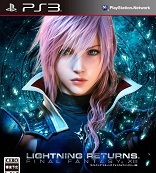Ni no Kuni
Nintendo DS
Reviewed: 10/9/2012
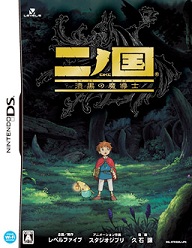 |
Ni no Kuni begins in the “real world,” in the idyllic-looking town of Hotroit, a representation of good ol’ white picket fence ‘Merica in its heyday. Hotroit produces cars, incidentally. Living in Hotroit is a young schoolboy named Oliver, who lives with his mother Ally in a cozy house. One day, after Oliver sneaks out to spend time with his friend Mark, an accident occurs, and while Oliver is safe in the end, his mother dies shortly after, from a mysterious illness. When mourning his mother, Oliver sheds tears on one of his dolls, who turns into the Great Fairy Shizuku, who hails from a sort of parallel world called “Ni no Kuni.” This other universe houses alternate versions of people, including the Sage Alicia, Ally’s counterpart. Shizuku was cursed by a dark sorcerer named Jabo, who has been spending his time terrorizing Ni no Kuni and capturing Alicia — you know, bad guy stuff. Suggesting to Oliver that there might be a way for him to help his mother by saving Alicia, Shizuku gives him a magic spell book and guides him to Ni no Kuni, where he must save people whose hearts have been cursed by Jabo.
Ni no Kuni doesn’t really bring the focus back to the real world except when convenient for the plot, which is disappointing for an alternate-reality tale. With the parallel characters, it would have been great to see what kinds of changes (or changes to Oliver’s perspective) might be wrought on the real world by his adventures in the other world, but other than some ho-hum NPCs, Hotroit is devoid of anything interesting to interact with. Dialogue in the real world changes occasionally, but it’s nothing to really draw the player back to Oliver’s home, other than a few interesting bits about the history of Hotroit.

What is immediately obvious about Ni no Kuni, from the opening minutes of the game, is the genuineness of the characters. Unlike most kid characters, Oliver is not bratty, overly selfless, excessively genki, naive, or whiny. He’s just a young kid who has lost his mom — he has his brave moments, hopeful moments, and moments where he cries, but none of them feel out of place or overacted. Though Ally has limited screentime, she’s utterly convincing as a loving mother without being too benevolent, sugary or smothering. Shizuku is funny, and full of bravado despite his small size, somehow without falling into the “pint-sized wisecracking sidekick” demographic. Though Oliver’s two human allies don’t have complex backstories or motivations, they radiate personality and don’t feel like they were thrown in for the heck of it. Even bit-part NPCs get dialogue that really establishes character.
The script is the best to come out of the genre in years. It proves that simple stories can be turned into masterpieces in the hands of competent writers. NPC dialogue feels more believable than that of most Japanese RPGs these days, as nearly every word serves to further the story or connect the player emotionally to the world. Their dilemmas are human dilemmas, that come about from personal ambitions or faults.
Many games have powerful graphics, but far fewer have powerful scripts to match. Even though it’se not the most showy part of the game, Ni no Kuni‘s amazing script might be the asset that most sets it apart from crowd filled with drivel.
Ni no Kuni‘s gameplay is a lot of ordinary, familiar systems put together really well. Most importantly, for all nostalgic RPG fans, it comes equipped with a vast world map, and reminds us all why we loved them in the first place. Ni no Kuni also has no random battles. On the world map and in dungeon screens, Oliver can avoid enemies with some fancy footwork, and all enemies move in different ways at different speeds, which adds a fun twist to a familiar mechanic. Some enemies trip and fall, some are fast for a few seconds then slow down, some can teleport close to Oliver, while others wind up for a few seconds and then blindly charge. Ni no Kuni also has a vanilla item creation system, with the player able to receive recipes from townspeople or try to create new items from scratch.
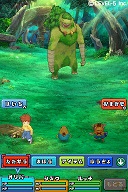 |
| We are the knights who say “Ni. No Kuni.” |
Oliver gains the ability to summon, then catch, heart-warrior-creatures called “Imajinns.” There are hundreds of these, and when trained, they can in turn evolve into more powerful forms; raising them properly helps to increase their abilities. Unlike Pokemon, Ni no Kuni doesn’t place a huge “gotta catch’em all” emphasis on Imajinns. They are useful fighters, but there is no reward for accumulating large numbers of them.
Shipped as part of a larger package, Ni no Kuni comes with a real-world version of the beautiful in-game spellbook, called the Magic Master. Throughout the game, players must consult the spell book to look up runes for new spells, hints, magic words, and more. Given its tremendous amount of content, it’s easy to derive enjoyment from just holding and leafing through the Magic Master. It does obviously put a slight dent in the game’s portability, however.
I’d previously wondered how exactly a game could be challenging when it’s shipped with a mandatory guide, but the guide portions of the book are cleverly disguised, so without playing the game, it’s hard to tell what is background lore and what is a legitimate game hint. Some diagrams are obviously hints, but it’s not always certain what for. This sounds annoying, but actually, the subtlety is wonderful, and reading the book feels like a treasure hunt sometimes — you never know what exactly you’ll find.
On the other hand, looking up new runes for spells makes sense within the context of the game, but trapping the player in inescapable dialogue loops until they look up the runes is bad design. Level-5 should have made it so that the player can’t advance without inputting the runes, sure, but at least given him a chance to save and turn off the system if for some reason the book isn’t around.
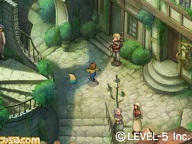 |
| But which way is Sesame Street? And which way is another popular culture reference? |
It’s unfortunate that Ni no Kuni, while incredible at doing all of the ordinary things that other games do, doesn’t really seize the day with its most unique elements. The book and the spells within it are underused, and the potential for meaningful puzzles that don’t involve lighting lamps or torches is criminally overlooked. Puzzles in which the player really has to think and search through the spell book the way Oliver might have are exactly the kind that could have given this game an edge over others. There are no bad dungeons, but no really fun or interesting ones that stick out, either. The puzzles inside them are usually simple, and often Shizuku blurts out the solution before the player really thinks about it. This reduces the dungeons to being little more than battle-filled mazes whose only differences are aesthetic.
At least the battles within dungeons are fun. Ni no Kuni‘s battle system is a traditional turn-based system (highest speed goes first, characters can use regular attacks, items or skills), with a Pokemon-style character switching mechanic and a few new tricks.
Character placement is important. The three party members are laid out on a 3×3 grid, and their placement can affect their physical and magical strength, their defense (further back equals less damage), and what attacks they might get hit by. For example, some attacks hit rows or columns, while others will begin to strike the grid from the front only to stop after hitting any target. This means that one character can be placed in front of another to block certain attacks. Characters blocking or being missed by attacks, as well as hitting enemy weaknesses, will gain Nice Points (as in “Nice! You totally smashed that thing’s face in!”). Initially, the battle system is simple, but later in the game, the choices regarding Imajinns will become very important.
 |
| I’m on a boat! |
The combat-related problem with Ni no Kuni is that it may be too easy to seasoned RPG veterans. The game is designed with all ages in mind, which makes this forgivable, but the fact remains, with nine reserve battle members, it’s really hard to die. With up to 21 characters on the roster for a dungeon, plus copious amounts of healing crystals and save points, there isn’t even the possibility of challenging dungeonplay. The extra content has some boss battles that can be devilishly difficult, but it’s too bad there isn’t much in the main story that really requires the strategical thinking that the battle system can require.
The graphics are stamped with Studio Ghibli’s trademark strengths: backgrounds crafted with an incredible eye for details (of worlds both familiar and fantastic), paired with simply drawn, yet colorful and uniquely expressive characters. Both of these strengths influence the aesthetics for the entire game, whether in the headline-making animated cutscenes, the in-game engine, or the carefully constructed menus. The animated bits are, of course, the cream of the crop, but praise can apply to the visuals as a whole. Not only are the graphics beautiful and lovingly rendered, they are used extremely effectively to build the world, to avoid repetition, and to foster emotion in players.
The small, intricate details of the hand-drawn backgrounds draw the player into these tiny worlds. No pieces of the town backgrounds, and almost none of the dungeon backgrounds, are recycled. Each tiny cobblestone is unique; every scene is filled with little touches that make it feel real. Battle backgrounds change very frequently, according to the landmarks that Oliver is close to. All menus have different adornments, according to their function. Every twitch of a character’s eyebrow, every change in posture, every movement and, given how often characters are moving, even every motionless moment conveys personality and emotion in a way that many highly polished console games can only dream of providing to their stiff-jawed, too-orchestrated characters. In fact, while many console games, and their character animations, seem blatantly directed, Ni no Kuni‘s characters look organic. They feel completely natural, and it does amazing things to establish their charm and their humanity. Even non-human characters and things, like a lurching, off-balance tank, or a ship tossed on stormy seas, look perfect in the ways they are portrayed.
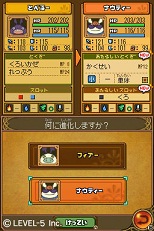 |
| So I guess when you evolve, you get complimentary sunglasses? |
Where its graphics alone can’t quite succeed in pulling you headfirst into the vivid landscapes of Ni no Kuni, the music is right behind you to give a decisive shove. It’s gorgeously crafted and fully orchestrated, with no electronic or synthesized notes to jar the ear out of this world–which has a very particular tone, that anything artificial-sounding would have surely ruined. The entire soundtrack is won by the world map theme alone, which somehow manages to convey both the grandness of the world, and the joyful energy of the cast adventuring within it.
Aside from Ni no Kuni being an excellent game, it has a lot of content that makes it worth picking up again and again. There are 100 help-the-townspeople sidequests (with additional quests available for download) that are discoverable throughout the game at special quest buildings, which range from defeating monsters to restoring heart pieces to tracking down certain Imagines. In the post-game, there’s a grueling 100-floor tower to tackle, with an additional ending sequence at the top, that somewhat redeems the easiness of the main game and brings out the potential of the battle system. The world map is studded with hidden treasures of all kinds, a sealed cave, and secret pirate booty. In one town, there’s a battle colosseum, a casino with minigames and special rewards, and a cutscene theater. There are quizzes, extra dialogue, a bizarre dream world, extra spells and skills to discover, wireless multiplayer battles…the list of extra content seems to go on and on. Not all of it is necessarily of the highest quality, but there’s just so much to discover in Ni no Kuni, and it really is a lot of fun, while being pretty friendly to completionists.
Ni no Kuni is what happens when ordinary and simple pieces are put together by skilled people in wonderful ways. It doesn’t dazzle with arcane mechanics, complicated story twists, tortured characters, or highly detailed polygons; it sticks to simplicity, and does that better than almost any other game on the market right now. It has a few flaws, and doesn’t stretch its wings and capitalize on some of its unique potential, but those flaws do not add up to anything that could drive people away from the game altogether. From its lifelike characters and high-quality script, to its gorgeous art and music, to the fun game systems, Ni no Kuni is a reminder of why people used to flock to the JRPG genre in the first place.
-Janelle Hindman
| Score Breakdown | ||
| Overall Great Out of 10 See our Review Criteria |
Gameplay | Great |
| Story | Excellent | |
| Graphics | Legendary | |
| Sound/Music | Great | |
| Replay Value | Good | |
| The Verdict: Great | ||






